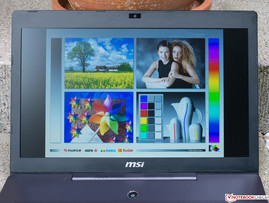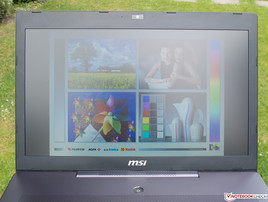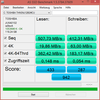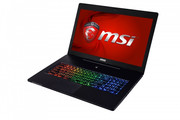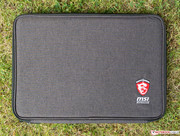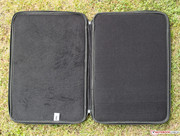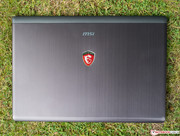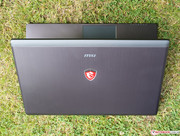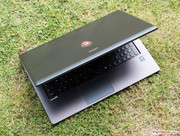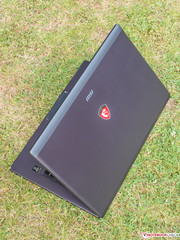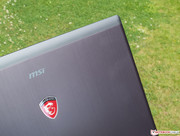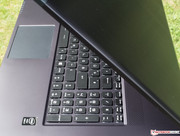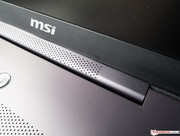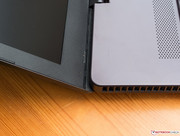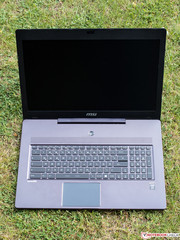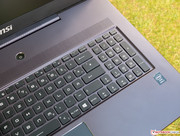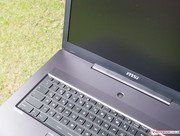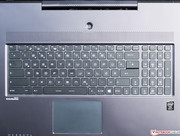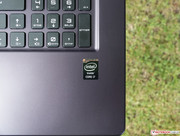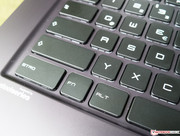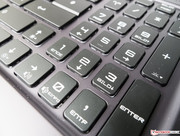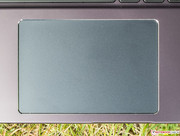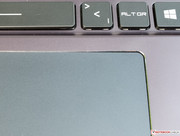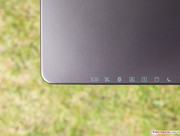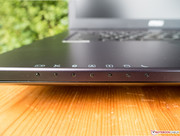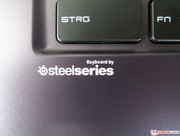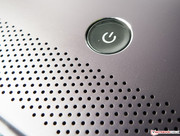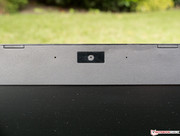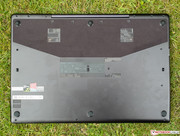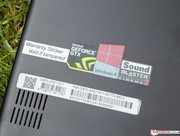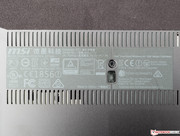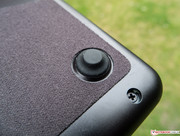MSI GS70-2PEi71611 Notebook Review

For the original German review, see here.
When seeing the approximately 2.7 kilogram (~6.0 pound) and only 2.2 centimeter (~0.87 inch) slim MSI GS70-2PEi71611 for the first time, it is hard to believe that it is not a common office or multimedia laptop, but a gaming machine with Intel's Core i7-4700HQ (4x 2.4 - 3.4 GHz, Hyperthreading, TDP: 47 Wh) and ultra-fast Nvidia GeForce GTX 870M. Space-consuming, heavy casings with a height of at least 4 centimeters (~1.57 inches) and a weight rarely under four kilograms (~8.8 pounds) are common in this category. Thus, the "only" 3.135 kilogram heavy Nexoc G728II (6.9 pounds, Clevo W370SS) that we selected as one of the two comparison devices for this test is an exception. However, MSI's slim gaming machine faces a maximum height of 4.4 centimeters (~1.73 inches). That is surpassed by the fourth comparison laptop Asus G750JS-T4064H (4.08 kilograms; 9.0 pounds) with a height of up to 5 centimeters (~1.97 inches). The screens of the three test devices are all based on TN displays with a Full HD resolution.
We made sure that all three comparison devices were roughly within the same hardware range when we chose the laptops. Asus also relies on the new GTX 870M with a dedicated GDDR5 RAM and also uses the same, not exactly economical and cool, CPU as the review sample. In return, Nexoc's G728II sports a virtually identical Intel Core i7-4700MQ (4x 2.4 - 3.4 GHz, Hyperthreading, TDP: 47W), and has to be satisfied with a slightly weaker GTX 860M with 2 GB of dedicated memory.
Besides the build, MSI touts the colorfully backlit, specifically designed for gaming needs and largely configurable, macro-capable keyboard, and the Dynaudio sound system as further unique selling points.
Case
MSI states that the casing is aluminum, but the tester had the feeling that it was plastic. Only a little effort is needed to warp it marginally, and it produces a quiet noise. The surfaces feature a matte, charcoal-black color that is not exceptionally sensitive to fingerprints. The build does not give much reason for complaint. We did not notice irregular gaps, or sharp and protruding edges. There was one exception: The touchpad's silver rim was spaced unevenly, and the construction looks a bit lopsided, which should be apparent in the screenshots on the right. The hinge occasionally produced a creaking noise when opening and closing the lid. The lid can be opened with one hand, but wobbles for quite a while when opened jerkily. The lid's back surface in a brushed-metal look makes a somewhat cheap impression. A matte lip is mounted at the display's upper edge, and sets a nice highlight alongside the illuminated MSI gaming logo.
Connectivity
MSI makes use of the available space and installs four USB 3.0 ports. That is just as appropriate for a device that will likely be used stationary despite its heralded portability as the Ethernet port. The buyer does not get VGA, but receives the more future-ready DisplayPort in a double pack. Since HDMI is also installed, up to three external monitors can be connected at the same time - alongside the installed screen according to MSI. The ports have been moved to the middle to front areas where connected peripherals and cords might be in the way because the vents are located on the back sides. Particularly the power socket positioning in the center right is unusually unfavorable.
Communication
A module dubbed Killer e2200 from Qualcomm is responsible for wired LAN. It is made for gaming, and is to contribute to a particularly low latency (ping). Besides that, it is possible to assign services and programs, such as games, to fixed network priorities, and create profiles. The review sample features Intel's ac-capable Gigabit Wi-Fi dual-band module. Its reception performance proved to be slightly above average in the tester's personal test setup.
Accessories
In addition to warranty documents, a quick start guide, a driver DVD with the user's manual, and a brochure named "Hot Key F3 Recovery Function", an appealing sleeve in fabric-look is found in the box - great.
Maintenance
The review sample's non-existent maintenance options are an ecological concern and customer-unfriendly. Not even the battery can be replaced without removing the base plate secured with screws, and risk the retailer's warranty and guaranty. Only the manufacturer benefits from this since it can demand an overpriced service fee for small things like cleaning the fan.
Warranty
MSI includes a 24-month pick-up and return warranty that can be upgraded up to four years at some retailers. MSI lists warranty upgrades on a corresponding page on its website, but the user will not immediately find a concrete offer.
Input Devices
Keyboard
MSI clearly deviates from the standard keyboard layout in some places. For example, the Windows key is omitted to prevent the problem of opening the desktop when hitting it accidentally, which allegedly frequently occurs during gaming sessions. We painfully missed this key during the test. The key for "<" and ">" is now found on the space bar's right, but the left shift key is agreeably wide in return. The number pad is too small in our opinion, and prevents inputting numbers quickly. The keys are spaced sufficiently, feature a medium drop, a well palpable pressure point, and a soft and very quiet stroke. The even surface has a velvety feel owing to the non-slip rubber coat. The tester subjectively had problems with the typing feel. The keyboard will unlikely yield in real-life usage though. The keyboard's highlight is doubtlessly its individually configurable, colorful three-zone back light besides the many personalization and profile options via hot keys and macros.
Touchpad
The ClickPad's roughened surface, which is touch-sensitive almost up to the edges and does not have dedicated, physical keys, provides good feedback. Drag and drop via double clicking was no problem, and we did not notice anything unfavorable about responsiveness or accuracy either. In the tester's opinion, the clickable areas have somewhat too high a resistance, but feature a crisp pressure point and good audible feedback. The ClickPad detects gestures with up to three fingers, and the configuration options in the ELAN driver should satisfy most requirements.
Display
MSI relies on a matte screen that offers a gaming-suitable resolution of 1920x1080 pixels (16:9). It is based on TN technology that involves a few drawbacks compared with IPS. However, it usually provides faster switching times than IPS, which will likely be more important for gamers than, for example, a high viewing angle stability. Not for nothing do most gaming laptops from the 2000 Euro (~$2736) price range feature a TN screen. Knowing this, alternative screens do not make much sense and are not available either.
The brightness of 306 cd/m² is very good, and is located between both comparison laptops, which also look comparatively impressive. We did not ascertain screen bleeding. An illumination of 81% is not awe-inspiring, but quite acceptable.
| MSI GS70-2PEi71611 GeForce GTX 870M, 4700HQ, Toshiba HG6 THNSNJ128GMCU | Asus G750JS-T4064H GeForce GTX 870M, 4700HQ, SanDisk SD5SE2256G1002E | Nexoc G728II GeForce GTX 860M, 4700MQ, Mushkin Atlas mSATA MKNSSDAT240GB | |
|---|---|---|---|
| Display | 9% | 2% | |
| Display P3 Coverage | 60.7 | 68.6 13% | 61.6 1% |
| sRGB Coverage | 84.4 | 90.1 7% | 85.9 2% |
| AdobeRGB 1998 Coverage | 61.7 | 65.9 7% | 62.8 2% |
| Screen | -5% | 3% | |
| Brightness middle | 306 | 276 -10% | 324 6% |
| Brightness | 303 | 273 -10% | 308 2% |
| Brightness Distribution | 81 | 88 9% | 81 0% |
| Black Level * | 0.33 | 0.48 -45% | 0.35 -6% |
| Contrast | 927 | 575 -38% | 926 0% |
| Colorchecker dE 2000 * | 11.25 | 8.24 27% | 9.81 13% |
| Greyscale dE 2000 * | 11.37 | 8.83 22% | 10.29 9% |
| Gamma | 2.64 83% | 2.51 88% | 2.62 84% |
| CCT | 14222 46% | 10215 64% | 12619 52% |
| Color Space (Percent of AdobeRGB 1998) | 54 | 59 9% | 55 2% |
| Total Average (Program / Settings) | 2% /
-1% | 3% /
3% |
* ... smaller is better
| |||||||||||||||||||||||||
Brightness Distribution: 81 %
Center on Battery: 306 cd/m²
Contrast: 927:1 (Black: 0.33 cd/m²)
ΔE Color 11.25 | 0.5-29.43 Ø5
ΔE Greyscale 11.37 | 0.57-98 Ø5.3
54% AdobeRGB 1998 (Argyll 1.6.3 3D)
61.7% AdobeRGB 1998 (Argyll 2.2.0 3D)
84.4% sRGB (Argyll 2.2.0 3D)
60.7% Display P3 (Argyll 2.2.0 3D)
Gamma: 2.64
The contrast of 927:1 is pleasantly high for a TN screen, and the black level of 0.33 cd/m² is also impressive. These two rates and the maximum brightness are proportional. Our Nexoc G728II is on par while the Asus G750JS is at the back with only 575:1. Black looks quite saturated on bright image sections. However, this impression naturally deteriorates when looking at an absolutely black picture in a dark room using maximum brightness.
The image sharpness is top notch. That, however, definitely does not apply to the color accuracy. A DeltaE rate of 11 in a non-calibrated state is much too high and causes the bluish cast only too well known from most TN screens. Although the contenders achieved a 9 - 27% better rate in the test, it cannot be called an ideal reproduction either. All three screens cover between 54 and 59% of the large AdobeRGB color space that is usually only significant for professional image editors. That is nevertheless very impressive for TN conditions.
MSI's GS70-2PEi71611 does a good job outdoors owing to its bright, matte screen. It should usually be possible to find a seating position where unaffected working is no problem even under sunny skies. Of course, very bright backgrounds or direct sunlight should be avoided, as can be seen on the right screenshot below this paragraph.
The screen's viewing angle stability is acceptable for TN technology. Although the contrast and brightness lessen when looking only from the right or left, the color reproduction remains fairly accurate. Even the milky image impression that occurs in TN-based screens when looking down stays within pleasant limits. In return, it gets more adverse when looking up because the usual inverting effect affects the view.
Performance
MSI's GS70-2PEi71611 sports the swift, yet also energy-devouring and high waste heat producing for today's standards, Intel Core i7-4700HQ. It can fall back on a whole 16 GB of DDR3 RAM. The new premium range Nvidia GeForce GTX 870M graphics chip with a speedy 3 GB of dedicated GDDR5 RAM is responsible for 3D rendering. Commercially available software, including highly parallelized programs like 3ds Max or even current, high-requirement games, rarely push the system to its limits. Users who are satisfied with a bit less graphics power will find GS70 configurations with the slower GTX 860M or GPUs from the former GTX 7xxM generation on MSI's corresponding page.
Processor
Due to the high TDP of 47 watts, the Core i7-4700HQ CPU (4x 2.4 - 3.4 GHz, Hyperthreading, 22 nm process) from Intel's current Haswell processor generation is actually only suitable for larger notebooks of 15 inches or more. That, however, did not stop Gigabyte from installing the chip in its new 14-inch P34G (review coming soon). Up to eight simultaneous threads and the high clock rates ensure smooth multitasking when high performance is more important than compact build, light weight, and low power consumption. The Turbo levels are specified as follows: four cores: 3.2 GHz; two cores: 3.3 GHz; one core: 3.4 GHz.
Cinebench 11.5, that assesses the pure processor performance, shows that the CPU does not always achieve the specified Turbo clock rates during load. They fluctuate between the base clock of 2.4 to 3.2 GHz. It is a stable 2.4 GHz when only the stress test via Prime95 runs. Though this behavior does not yet indicate throttling, the CPU remains behind its (theoretical) potential, which is also due to the faulty thermal management that we will deal with later. While the three test laptops all with equally strong processors compute just as fast as MSI's G70 when only one core is loaded, the multi-CPU test records a deficit of 7 to 10% for the review sample, which exactly fits in the picture. Of all laptops tested with this CPU to date, the review sample calculates the slowest by up to 12%.
| Cinebench R11.5 | |
| CPU Multi 64Bit (sort by value) | |
| MSI GS70-2PEi71611 | |
| Asus G750JS-T4064H | |
| Asus G750JS-T4064H | |
| Nexoc G728II | |
| CPU Single 64Bit (sort by value) | |
| MSI GS70-2PEi71611 | |
| Asus G750JS-T4064H | |
| Asus G750JS-T4064H | |
| Nexoc G728II | |
System Performance
We use the latest PCMark 7 and 8 to ascertain the system's total performance. They simulate different application scenarios, such as "Home" or "Creative", each with a different weighting of CPU, graphics, and storage device performance. There are no significant differences to both other laptops, and the performance is throughout on the expected level. Possibly, the minor weaknesses of MSI's laptop in the multi-core performance are balanced by the SSD's partly somewhat superior performance. Subjectively, we would describe the performance as swift, and excessive multitasking could not change that either.
| MSI GS70-2PEi71611 GeForce GTX 870M, 4700HQ, Toshiba HG6 THNSNJ128GMCU | Asus G750JS-T4064H GeForce GTX 870M, 4700HQ, SanDisk SD5SE2256G1002E | Nexoc G728II GeForce GTX 860M, 4700MQ, Mushkin Atlas mSATA MKNSSDAT240GB | |
|---|---|---|---|
| PCMark 7 | -10% | -3% | |
| Score | 5740 | 5348 -7% | 5664 -1% |
| Entertainment | 4567 | 3946 -14% | 4425 -3% |
| Creativity | 9944 | 9150 -8% | 9426 -5% |
| PCMark 8 | -6% | 3% | |
| Home Score Accelerated v2 | 3465 | 3195 -8% | 3581 3% |
| Creative Score Accelerated v2 | 4956 | 4775 -4% | 5054 2% |
| Total Average (Program / Settings) | -8% /
-8% | 0% /
-1% |
| PCMark 7 Score | 5740 points | |
| PCMark 8 Home Score Accelerated v2 | 3465 points | |
| PCMark 8 Creative Score Accelerated v2 | 4956 points | |
| PCMark 8 Work Score Accelerated v2 | 4286 points | |
Help | ||
Storage Devices
The dedicated AS SSD solid-state drive benchmark recorded very high data throughput for the review sample in sequential read and places the review sample clearly before both contenders. However, the benchmarks also confirmmiddling performance in read of small, random data blocks (4k). That is also the only test where the otherwise hopelessly inferior mSSD in Nexoc's G728II can be considered above average. The results of MSI's GS70 in the 4k-64 Read and 4k QD 32 are strikingly good. The tests simulate system and program starts. The additionally installed, one GB hard drive fares excellently.
| MSI GS70-2PEi71611 GeForce GTX 870M, 4700HQ, Toshiba HG6 THNSNJ128GMCU | Asus G750JS-T4064H GeForce GTX 870M, 4700HQ, SanDisk SD5SE2256G1002E | Nexoc G728II GeForce GTX 860M, 4700MQ, Mushkin Atlas mSATA MKNSSDAT240GB | |
|---|---|---|---|
| AS SSD | 5% | -49% | |
| Seq Read | 508 | 437 -14% | 198.9 -61% |
| 4K Read | 19.86 | 28.81 45% | 17.57 -12% |
| 4K-64 Read | 362.4 | 302.8 -16% | 96.6 -73% |
| CrystalDiskMark 3.0 | 11% | -28% | |
| Read Seq | 521 | 502 -4% | 208.3 -60% |
| Read 4k | 20.75 | 31.32 51% | 31.27 51% |
| Read 4k QD32 | 377.1 | 326.3 -13% | 93.8 -75% |
| Total Average (Program / Settings) | 8% /
8% | -39% /
-38% |
Graphics Card
With the Nvidia GeForce GTX 870M launched in early 2014, MSI's GS70 sports one of the currently fastest laptop graphics cards. The 1344 shader units of the DirectX 11 chip oppose the 1536 of the even faster GTX 880M, and the width of the memory bus has been reduced from 256 to 192 bits. The power should actually be enough to render all current and graphically intricate tracks smoothly even in maximum settings.
There is no doubt that extreme GPU throttling occurs during load (see Temperature), but it cannot be proved based on the 3DMark 2013 scores. The rates were all on a top level, and even the much larger Asus G750JS only achieved a 5% higher score in the single, graphic-heavy benchmarks. Nexoc's G728II lags behind slightly due to its weaker GTX 860M. 3DMark 11 recorded an advantage of as high as 48% for Asus' device over MSI's. Throttling apparently had a much stronger effect here. The 3D performance dropped massively in battery mode.
| MSI GS70-2PEi71611 GeForce GTX 870M, 4700HQ, Toshiba HG6 THNSNJ128GMCU | Asus G750JS-T4064H GeForce GTX 870M, 4700HQ, SanDisk SD5SE2256G1002E | Nexoc G728II GeForce GTX 860M, 4700MQ, Mushkin Atlas mSATA MKNSSDAT240GB | |
|---|---|---|---|
| 3DMark | 3% | -8% | |
| 1920x1080 Fire Strike Score | 4198 | 4384 4% | 3685 -12% |
| 1920x1080 Fire Strike Graphics | 4558 | 4802 5% | 3947 -13% |
| 1920x1080 Fire Strike Physics | 8944 | 8841 -1% | 8728 -2% |
| 1280x720 Cloud Gate Standard Score | 16994 | 15914 -6% | |
| 1280x720 Cloud Gate Standard Graphics | 32151 | 28353 -12% | |
| 1280x720 Cloud Gate Standard Physics | 6413 | 6277 -2% | |
| 3DMark 11 | |||
| 1280x720 Performance | 4831 | 7151 48% | 5257 9% |
| Total Average (Program / Settings) | 26% /
14% | 1% /
-5% |
| 3DMark 11 Performance | 4831 points | |
| 3DMark Cloud Gate Standard Score | 16994 points | |
| 3DMark Fire Strike Score | 4198 points | |
Help | ||
Gaming Performance
As the chart below shows, the 3D performance is enough to play most current games smoothly with maximum settings. The comparison with other laptops based on the same GPU and comparable CPU has proven, however, that more would have been possible without the extreme GPU throttling - depending on the game and settings by up to 68%. To what extent throttling occurs naturally depends on how long the laptop has been under full load at the time of the measurement, and the ambient temperature. We, for example, achieved considerably better results after idle periods than the ones listed here. However, no one will play for only a few minutes so that these rates are based on realistic conditions. It is strange that Crysis 3 was not affected. The idle periods between the benchmarks in different settings were obviously enough to cool down the device. We attached a comparison under the verdict that shows the dilemma based on a few games. The marginally faster CPU of the listed comparison laptops does not explain the big differences.
| low | med. | high | ultra | |
| Total War: Shogun 2 (2011) | 220.2 | 98.9 | 44.95 | |
| Batman: Arkham City (2011) | 210 | 199 | 129 | 56 |
| Dishonored (2012) | 129.7 | 127.5 | 128.5 | 97.4 |
| Medal of Honor: Warfighter (2012) | 180.6 | 94.9 | 74.4 | 29.6 |
| Crysis 3 (2013) | 129 | 96 | 65 | 25 |
| Tomb Raider (2013) | 310 | 121.8 | 85.9 | 36.2 |
| BioShock Infinite (2013) | 186.5 | 120.1 | 99.9 | 34.77 |
| Battlefield 4 (2013) | 134.1 | 89.2 | 64 | 24 |
| Wolfenstein: The New Order (2014) | 60 | 60 | 57.2 | 42 |
Emissions
System Noise
We questioned whether MSI keeps control over the noise considering the unusually slim build for a gaming laptop in the intro. The GS70 does not do an exceptionally bad job, although both comparison laptops produce up to 13% less noise particularly during full load. The laptop usually remains silent when idling. In a YouTube video we hear that the fans are still very reserved, and can barely be distinguished from normal ambient noise. This changes when Prime95 and FurMark are run. Full load causes a loud noise that fortunately is not accompanied by annoying side noises. However, we occasionally had problems with a kind of high-pitched whistling and pulsating sound in medium, consistent speeds.
Noise Level
| Idle |
| 29.2 / 34.2 / 36.2 dB(A) |
| HDD |
| 32 dB(A) |
| Load |
| 49.6 / 50.8 dB(A) |
 | ||
30 dB silent 40 dB(A) audible 50 dB(A) loud |
||
min: | ||
Temperature
MSI cannot invalidate the laws of physics when it comes to thermal issues; the installed fans are definitely too small. The only area of the laptop that still has tolerable temperatures when playing demanding games is in front of the keyboard. Both the laptop's back area and underside reach such a high temperature that no one will want to pick it up anymore. Use on the lap is only possible during medium load.
Consequently, the stress test comprised of Prime95 and FurMark showed the expected: While the CPU cores (max. 98 °C; 208.4 °F) remained stable at their base clock of 2.4 GHz, the GeForce GTX 870M could no longer surpass 405 MHz with up to 93 °C (199.4 °F). Its clock rate even occasionally dropped to 202.5 MHz. This proves that we are dealing with extreme throttling that will also limit the GPU's performance in real-life use.
(-) The maximum temperature on the upper side is 52.2 °C / 126 F, compared to the average of 40.4 °C / 105 F, ranging from 21.2 to 68.8 °C for the class Gaming.
(-) The bottom heats up to a maximum of 63.4 °C / 146 F, compared to the average of 43.2 °C / 110 F
(+) In idle usage, the average temperature for the upper side is 28.3 °C / 83 F, compared to the device average of 33.8 °C / 93 F.
(-) The palmrests and touchpad can get very hot to the touch with a maximum of 43.6 °C / 110.5 F.
(-) The average temperature of the palmrest area of similar devices was 28.9 °C / 84 F (-14.7 °C / -26.5 F).
Speakers
Though the built-in Dynaudio Soundbar achieves a decent maximum volume, it barely convinces otherwise. The sound rendered in both music and games is mid-heavy and flat; the speakers sometimes struggle with distortions. Consequently, (singing) voices sound unnaturally present, and often penetrating in high volumes. Low pitches cannot be rendered 1:1 despite the subwoofer because it lacks the necessary richness; nor can we speak of a real surround sound, but at least we can confirm that the sound system has viable dynamics. Speech is well intelligible. We used the default setting "Music", which makes use of various software tweaks for alleged sound enhancement.
Energy Management
Power Consumption
Both the Asus G750JS and Nexoc G728II are sometimes considerably more frugal in low to medium load than the review sample. This changes during average load. The undersized 150-Watt power supply limits the power consumption of MSI's laptop during full load. The 0.4 Watts in standby are too high. The average idle and full load consumption is below that for the mentioned reasons in the category comparison (gaming, 17.3 inches).
| Off / Standby | |
| Idle | |
| Load |
|
Battery Runtime
No one expects exceptionally long battery runtimes from a gaming laptop - although MSI particularly touts better mobility for its relatively slim and light GS70. It is possible to play a game on the go for approximately one and a half hours. The review sample achieved 235 minutes in the practical Wi-Fi test, where the screen's brightness is reduced to approximately 150 cd/m² in the energy-saving profile, and selected, representative Internet sites are opened at regular intervals via a script. That is an average time in the category comparison. Asus' G750JS surpasses that with a better 323 minutes.
Verdict
The experiment failed. MSI's new GS70-2PEi71611 can only be recommended to gamers who willingly give up decisive fps for a lower weight and slim build, and are satisfied with lower settings in many games than other comparably configured laptops would render smoothly.
The total score shows that it is not at all a bad laptop. Its appealing looks, an application performance beyond any doubt, the included sleeve, and the first-rate gaming keyboard are only some of the qualities on the pro side that add up to a good rating. The sharp screen is also very impressive.
The limited performance, particularly its cause, i.e. the completely messed up thermal management, has a negative impact on the rating. Users looking for a powerful and reasonably designed gaming laptop should not make compromises with a device like MSI's GS70 but rather consider, for example, the Asus G750JS. Though it is big and heavy, the G750JS fulfills its purpose perfectly. Should less power be enough, and a lower price is also wanted, it would be worthwhile to look at laptops with Nvidia's GeForce GTX 860M.
| Crysis 3 | |
| 1920x1080 Very High Preset AA:2xSM AF:16x (sort by value) | |
| MSI GS70-2PEi71611 | |
| MSI GT60-2PC81B | |
| One K73-4N | |
| 1366x768 High Preset AA:FX AF:16x (sort by value) | |
| MSI GS70-2PEi71611 | |
| MSI GT60-2PC81B | |
| One K73-4N | |
| BioShock Infinite | |
| 1920x1080 Ultra Preset, DX11 (DDOF) (sort by value) | |
| MSI GS70-2PEi71611 | |
| MSI GT60-2PC81B | |
| One K73-4N | |
| 1366x768 High Preset (sort by value) | |
| MSI GS70-2PEi71611 | |
| MSI GT60-2PC81B | |
| One K73-4N | |
| Tomb Raider | |
| 1920x1080 Ultra Preset AA:FX AF:16x (sort by value) | |
| MSI GS70-2PEi71611 | |
| MSI GT60-2PC81B | |
| One K73-4N | |
| 1366x768 High Preset AA:FX AF:8x (sort by value) | |
| MSI GS70-2PEi71611 | |
| MSI GT60-2PC81B | |
| One K73-4N | |
| Battlefield 4 | |
| 1920x1080 Ultra Preset AA:4x MS (sort by value) | |
| MSI GS70-2PEi71611 | |
| MSI GT60-2PC81B | |
| One K73-4N | |
| 1366x768 High Preset (sort by value) | |
| MSI GS70-2PEi71611 | |
| MSI GT60-2PC81B | |
| One K73-4N | |
| Wolfenstein: The New Order | |
| 1920x1080 Ultra Preset (sort by value) | |
| MSI GS70-2PEi71611 | |
| Schenker W504 | |
| 1920x1080 High Preset (sort by value) | |
| MSI GS70-2PEi71611 | |
| Schenker W504 | |


 Deutsch
Deutsch English
English Español
Español Français
Français Italiano
Italiano Nederlands
Nederlands Polski
Polski Português
Português Русский
Русский Türkçe
Türkçe Svenska
Svenska Chinese
Chinese Magyar
Magyar














